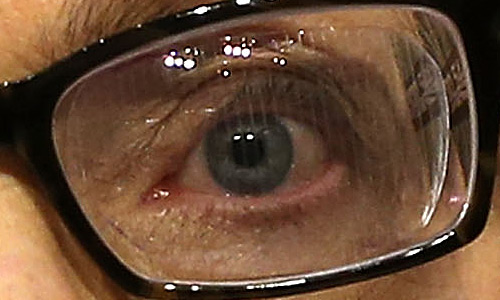Hillary Clinton’s Fresnel Prism Glasses
January 25th, 2013Some people (with zero skills of discernment) are submitting links to stupid websites talking about “Hillary Clinton’s teleprompter glasses,” etc.
Those are not teleprompter glasses, Google Glass or any technology related to digital displays.
Here’s a pic of what this is all about. Here’s a crop of that image:
What you’re looking at above is a fresnel prism.


How appropriate! Fresnel lenses are what are used in light houses. With Hillary manifesting the light of U.S. democracy™ to the rest of the lowly, darkened world, her fresnel lense glasses will help focus the brilliant light emanating from her soul that otherwise spews broadly out her eyes in such a god-like way.
Shine on you crazy diamond. Perhaps you can soon trade your walk-on part in a war for a lead roll in a cage.
I don’t know anything about the use of Fresnel glasses (other than what I just read here). I did notice her glasses and just figured she was going for a Henry Kissinger look.
http://apple.copydesk.org/uploads/2010/07/100716HenryKissingerNosePicking.jpg
So she had a stroke? !!!
Use of fresnel prism glasses to treat stroke patients with hemispatial neglect.
http://www.ncbi.nlm.nih.gov/pubmed/17141653
Keane S, Turner C, Sherrington C, Beard JR.
Source
Department of Rural Health, Northern Rivers University, Lismore, NSW, Australia. sheilak@nrahs.nsw.gov.au
Abstract
OBJECTIVE:
To explore the functional effects of prism adaptation training on patients with hemispatial neglect after stroke.
DESIGN:
Observational study.
SETTING:
Inpatient rehabilitation unit in rural Australia.
PARTICIPANTS:
Four subjects with hemispatial neglect, recruited from consecutive admissions of patients less than 60 days poststroke.
INTERVENTION:
Prism adaptation treatment, consisting of five 10-minute training sessions over 12 to 17 days.
MAIN OUTCOME MEASURES:
The FIM instrument, Catherine Bergego Scale (CBS), subjective straight ahead pointing, Albert’s line cancellation, letter cancellation, and line bisection. Ambulatory patients also performed the Timed Up & Go test.
RESULTS:
Immediate effects of prism adaptation training included improvements in both subjective straight ahead pointing and in the Albert’s line cancellation task. Letter cancellation, line bisection, FIM, and CBS scores improved in all subjects. Improvements in a functional task were also observed immediately following prism adaptation treatment. Obstacle avoidance while walking improved after prism adaptation training in 2 ambulatory subjects.
CONCLUSIONS:
Prism adaptation training shows promise as a new treatment to supplement current strategies for the clinical management of hemispatial neglect after stroke. This study is limited by small sample size and absence of a control group. Further research will be needed to demonstrate efficacy for this inexpensive and relatively safe device.
PMID: 17141653 [PubMed – indexed for MEDLINE]
————————————–
Hemispatial neglect.
Parton A, Malhotra P, Husain M.
Source
Division of Neuroscience and Psychological Medicine, Imperial College London, London W6, UK.
Abstract
The syndrome of hemispatial neglect is characterised by reduced awareness of stimuli on one side of space, even though there may be no sensory loss. Although it is extremely common, it has proven to be a challenging condition to understand, and to treat. New insights from detailed behavioural and anatomical studies in patients, as well as functional imaging in healthy individuals, have begun to reveal some of the component deficits underlying the disorder. This review focuses on important clinical issues in neglect, including bedside diagnostic tests and emerging therapeutic and rehabilitation methods, involving both behavioural and drug treatments.
http://www.ncbi.nlm.nih.gov/pubmed/14707298
…
Well that would explain her fall at home and “concussion” recently.